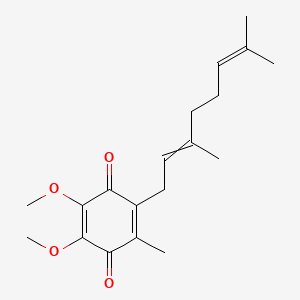CASRN: 1339-63-5

Drug Levels and Effects
Summary of Use during Lactation
Coenzyme Q10 (ubiquinone) is a normal part of the diet, and is also endogenously synthesized. It is a normal component of human milk, but milk levels are slightly low in the breastmilk of mothers with preterm infants. Coenzyme Q10 has no specific lactation-related uses and no data exist on the safety and efficacy of supplementation in nursing mothers or infants. Coenzyme Q10 supplements are usually well tolerated with only infrequent, minor side effects.
Dietary supplements do not require extensive pre-marketing approval from the U.S. Food and Drug Administration. Manufacturers are responsible to ensure the safety, but do not need to prove the safety and effectiveness of dietary supplements before they are marketed. Dietary supplements may contain multiple ingredients, and differences are often found between labeled and actual ingredients or their amounts. A manufacturer may contract with an independent organization to verify the quality of a product or its ingredients, but that does not certify the safety or effectiveness of a product. Because of the above issues, clinical testing results on one product may not be applicable to other products. More detailed information about dietary supplements is available elsewhere on the LactMed Web site.
Drug Levels
Milk levels of coenzyme Q10 have not been measured after exogenous administration in humans. Coenzyme Q10 is a normal component of human milk; however, values appear to vary depending on the country in which they are measured, possibly because of dietary, genetic or other population differences as well as assay differences.[1]
Maternal Levels. A study in 15 Italian mothers found a mean milk coenzyme Q10 concentrations of 1.6 mg/L at 4 days postpartum, compared to a maternal plasma concentration of 1.29 mg/L at the time of delivery.[2]
Coenzyme Q10 milk levels were measured in 23 German women who were between 24 to 48 hours postpartum, and again at 7 and 14 days postpartum. Milk levels were 1.1, 1.0 and 0.9 mg/L, respectively, at those times. The study found no correlation between maternal plasma levels and milk coenzyme Q10 levels in mature milk.[3]
Coenzyme Q10 milk levels were measured in 30 Spanish women on days 3, 8 and 30 postpartum. Half had delivered preterm infants and the other half had delivered fullterm infants. The estimated intake of coenzyme Q10 from food diaries were 3.2 mg daily in the preterm group and 2.7 mg daily in the fullterm group. In the preterm group, milk levels were 0.43, 0.39 and 0.36 mg/L, respectively, at those times. In the fullterm group, milk levels were 0.69, 0.65 and 0.47 mg/L, respectively, at those times.[4]
Forty-three breastmilk samples were obtained from 32 Japanese women during the first 8 days postpartum. The mean coenzyme Q10 concentration was 0.35 mcg/L.[5]
Thirty-nine lactating women in the United States donated 194 samples of breastmilk for analysis. The average milk concentration of coenzyme Q10 was 0.27 mcg/L.[1]
Infant Levels. Plasma concentrations of coenzyme Q10 have not been measured in the plasma of breastfed infants after maternal supplementation. However, a study in 15 Italian mothers and their breastfed infants found infant coenzyme Q10 plasma concentrations of 49 mg/L at 4 days and 0.41 mg/L at 4 weeks of age. The mean maternal coenzyme Q10 plasma concentration at delivery was 1.29 mg/L.[2]
Effects in Breastfed Infants
Relevant published information was not found as of the revision date.
Effects on Lactation and Breastmilk
Relevant published information was not found as of the revision date.
References
- 1.
- Tang PH, Miles MV, Steele P, et al. Determination of coenzyme Q(10) in human breast milk by high-performance liquid chromatography. Biomed Chromatogr. 2006;20:1336–43. [PubMed: 16883549]
- 2.
- Compagnoni G, Giuffre B, Lista G, et al. CoQ10 plasmatic levels in breast-fed infants compared to formula-fed infants. Biol Neonate. 2004;86:165–9. [PubMed: 15237239]
- 3.
- Niklowitz P, Menke T, Giffei J, et al. Coenzyme Q10 in maternal plasma and milk throughout early lactation. Biofactors. 2005;25:67–72. [PubMed: 16873931]
- 4.
- Quiles JL, Ochoa JJ, Ramírez-Tortosa MC, et al. Coenzyme Q concentration and total antioxidant capacity of human milk at different stages of lactation in mothers of preterm and full-term infants. Free Radic Res. 2006;40:199–206. [PubMed: 16390829]
- 5.
- Todoroki Y, Tsukahara H, Ohshima Y, et al. Concentrations of thioredoxin, a redox-regulating protein, in umbilical cord blood and breast milk. Free Radic Res. 2005;39:291–7. [PubMed: 15788233]
Substance Identification
Substance Name
Coenzyme Q10
Scientific Name
Ubiquinone
CAS Registry Number
1339-63-5
Drug Class
Breast Feeding
Lactation
Complementary Therapies
Coenzymes
Disclaimer: Information presented in this database is not meant as a substitute for professional judgment. You should consult your healthcare provider for breastfeeding advice related to your particular situation. The U.S. government does not warrant or assume any liability or responsibility for the accuracy or completeness of the information on this Site.
Publication Details
Publication History
Last Revision: May 17, 2021.
Copyright
Attribution Statement: LactMed is a registered trademark of the U.S. Department of Health and Human Services.
Publisher
National Institute of Child Health and Human Development, Bethesda (MD)
NLM Citation
Drugs and Lactation Database (LactMed®) [Internet]. Bethesda (MD): National Institute of Child Health and Human Development; 2006-. Coenzyme Q10. [Updated 2021 May 17].